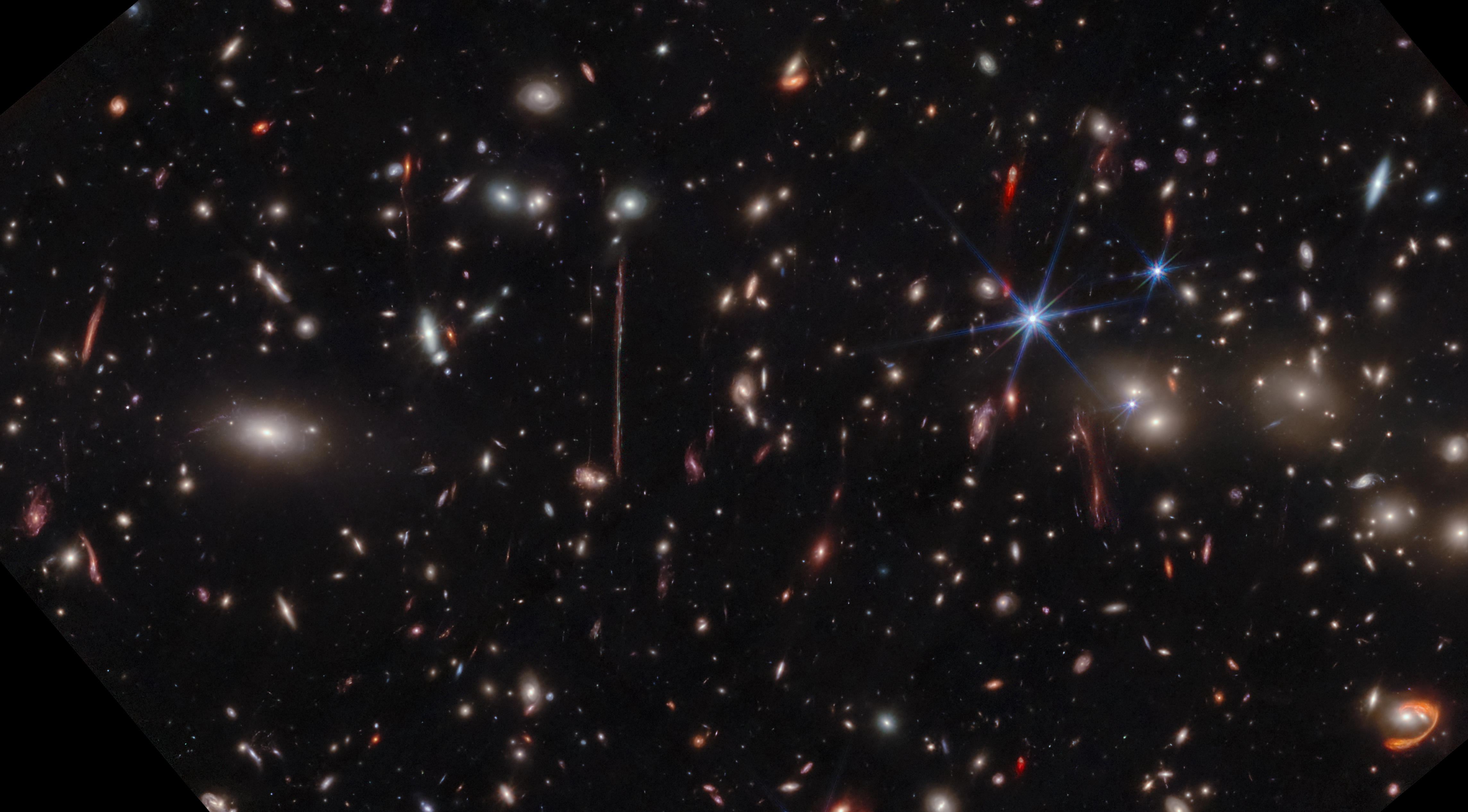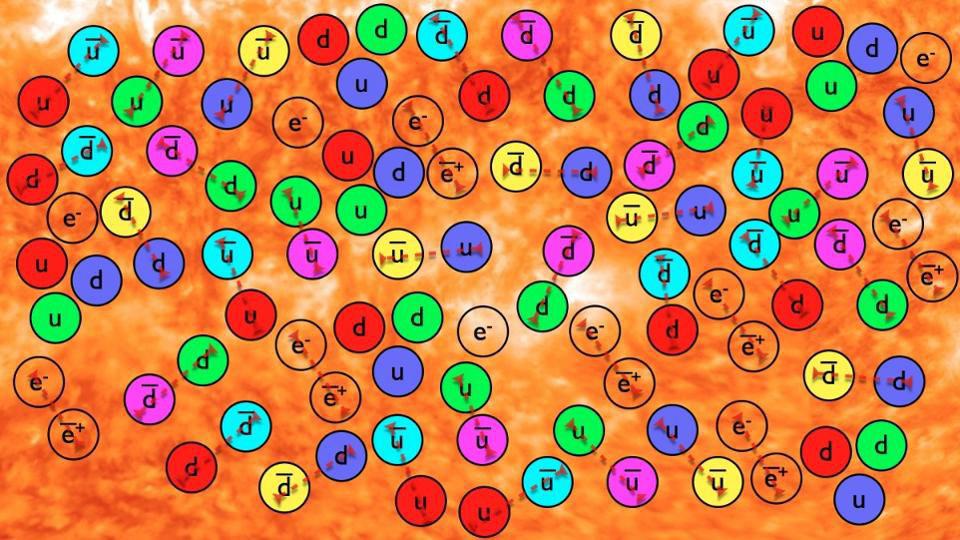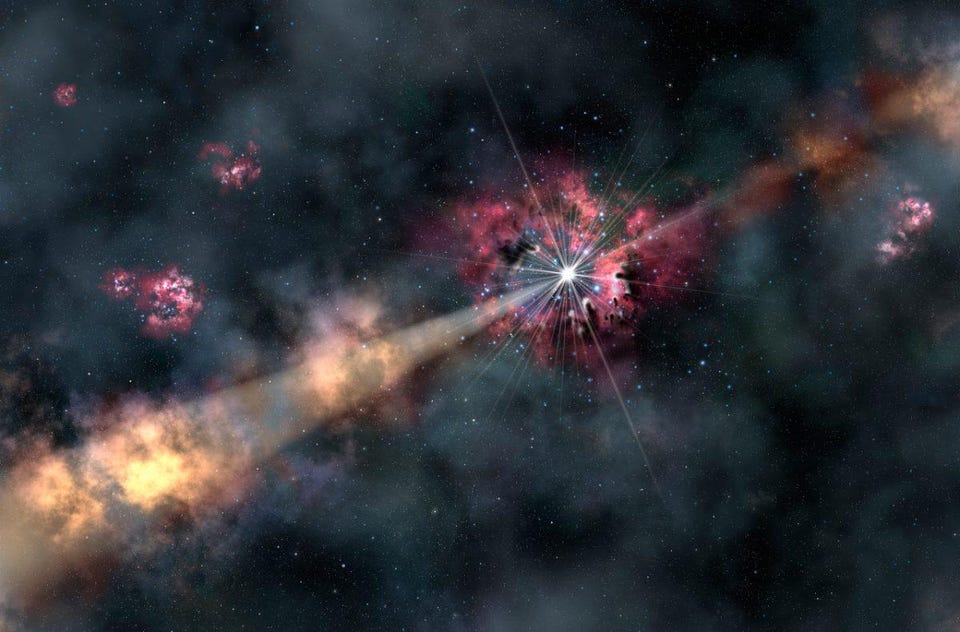 This image shows the most interesting regions of the El Gordo galaxy cluster as imaged by JWST and the PEARLS collaboration: the regions where gravitational lensing effects are strongest. Although the light from the main galaxy cluster comes to us from 7.6 billion years ago, even more distant background objects have their light stretched, distorted, and magnified by the foreground cluster. El Gordo, for its time in the Universe, is the largest, most massive galaxy cluster known, with "La Flaca" prominently visible to the left of center.
Credit: Jose M. Diego (IFCA), Brenda Frye (University of Arizona), Patrick Kamieneski (ASU), Tim Carleton (ASU), Rogier Windhorst (ASU); Processing: Alyssa Pagan (STScI), Jake Summers (ASU), Jordan C. J. D’Silva (UWA), Anton M. Koekemoer (STScI), Aaron Robotham (UWA), Rogier Windhorst (ASU)
Key Takeaways
This image shows the most interesting regions of the El Gordo galaxy cluster as imaged by JWST and the PEARLS collaboration: the regions where gravitational lensing effects are strongest. Although the light from the main galaxy cluster comes to us from 7.6 billion years ago, even more distant background objects have their light stretched, distorted, and magnified by the foreground cluster. El Gordo, for its time in the Universe, is the largest, most massive galaxy cluster known, with "La Flaca" prominently visible to the left of center.
Credit: Jose M. Diego (IFCA), Brenda Frye (University of Arizona), Patrick Kamieneski (ASU), Tim Carleton (ASU), Rogier Windhorst (ASU); Processing: Alyssa Pagan (STScI), Jake Summers (ASU), Jordan C. J. D’Silva (UWA), Anton M. Koekemoer (STScI), Aaron Robotham (UWA), Rogier Windhorst (ASU)
Key Takeaways
- Here on American Thanksgiving, the fourth Thursday of every November, we set aside time to appreciate all we have in this world, and all the collective efforts that made it possible.
- And yet, during most other times and in most places in the world, the idea of being thankful for the very things that make our existence possible is a forgotten pastime: something frequently overlooked.
- In addition to the efforts and kindnesses of others, there are a great many things worth giving thanks for: not just today, but every day.
Every day, we have a choice whether we take our lives, our existence, our freedoms, and our moments for granted, or whether we express appreciation and gratitude for the good things that exist. The biggest unifier that all human beings have in common, that we all exist on the same world and in the same Universe, never gets the due it deserves. Here and now, it’s possible for us to exist, and to exist as long as our natural lifespans will allow us.
This wasn’t guaranteed from first principles, but simply happens to be. At a huge number of different points in our Universe’s history, the laws of nature came together in such a way to enable our existence, and to allow us to look back today, 13.8 billion years later, with thankfulness in our hearts. Here are ten phenomena that made it all possible, and ten reasons to give thanks.
 This timeline of the Universe shows how, from a Planck-scale region of space that possessed an inflationary state, the properties of the hot Big Bang were set up beforehand. Once the Big Bang occurs, our Universe becomes filled with a primordial particle soup, which evolves into the atoms, stars, galaxies, and large-scale structures we’re familiar with today. However, unanswered questions about inflation, including what the pre-inflationary state was and how it began, still remain.
Credit: Ben Gibson/NASA/Pablo Carlos Budassi/Big Think
This timeline of the Universe shows how, from a Planck-scale region of space that possessed an inflationary state, the properties of the hot Big Bang were set up beforehand. Once the Big Bang occurs, our Universe becomes filled with a primordial particle soup, which evolves into the atoms, stars, galaxies, and large-scale structures we’re familiar with today. However, unanswered questions about inflation, including what the pre-inflationary state was and how it began, still remain.
Credit: Ben Gibson/NASA/Pablo Carlos Budassi/Big Think
1.) Be thankful that the Big Bang occurred.
As far as our Universe is concerned, there was a “day without a yesterday,” where the expanding, cooling, matter-and-radiation-filled Universe didn’t exist as such. The end of whatever state came before the Big Bang (likely cosmic inflation) gave rise to a Universe full of particles, antiparticles, radiation, and all the ingredients necessary to make our existence possible. Without the Big Bang, none of us would be here.
 In the very early Universe, there were tremendous numbers of quarks, leptons, antiquarks, and antileptons of all species. After only a tiny fraction-of-a-second has elapsed since the hot Big Bang, most of these matter-antimatter pairs annihilate away, leaving a very tiny excess of matter over antimatter. How that excess came about is a puzzle known as baryogenesis, and it is one of the greatest unsolved problems in modern physics.
Credit: E. Siegel/Beyond the Galaxy
In the very early Universe, there were tremendous numbers of quarks, leptons, antiquarks, and antileptons of all species. After only a tiny fraction-of-a-second has elapsed since the hot Big Bang, most of these matter-antimatter pairs annihilate away, leaving a very tiny excess of matter over antimatter. How that excess came about is a puzzle known as baryogenesis, and it is one of the greatest unsolved problems in modern physics.
Credit: E. Siegel/Beyond the Galaxy
2.) Be thankful for an asymmetric Universe.
There are all sorts of important symmetries, but if everything were completely symmetric, there would have been perfectly equal amounts of matter and antimatter. As the Universe cooled and expanded, they would have annihilated away almost completely, leaving just a sparse set of particles and antiparticles less than one-billionth as dense as the Universe today. But instead, we have a Universe filled with matter and not antimatter, and that makes all the difference. How that asymmetry came to be is still a mystery, albeit one with many possible outcomes. Nevertheless, that the Universe is asymmetric is a certainty, and one that enabled our very existence.
 The existence of complex, carbon-based molecules in star forming regions is interesting, but isn’t anthropically demanded. Here, glycolaldehydes, an example of simple sugars, are illustrated in a location corresponding to where they were detected in an interstellar gas cloud: offset from the region presently forming new stars the fastest. Interstellar molecules are common, with many of them being complex and long-chained.
Credit: ALMA (ESO/NAOJ/NRAO)/L. Calçada (ESO) & NASA/JPL-Caltech/WISE Team
The existence of complex, carbon-based molecules in star forming regions is interesting, but isn’t anthropically demanded. Here, glycolaldehydes, an example of simple sugars, are illustrated in a location corresponding to where they were detected in an interstellar gas cloud: offset from the region presently forming new stars the fastest. Interstellar molecules are common, with many of them being complex and long-chained.
Credit: ALMA (ESO/NAOJ/NRAO)/L. Calçada (ESO) & NASA/JPL-Caltech/WISE Team
3.) Be thankful for atoms.
It’s an absolute necessity for our existence that we have heavy nuclei that come in a variety of possible, stable configurations. Additionally, we need light, stable, and oppositely-charged particles (electrons) in order to form the building blocks of everything in our world. The particles in our Universe, when they cool, contract and bind together, form these atoms, which then clump and cluster together to give rise to the structure our Universe exhibits today.
4.) Be thankful for the gravitational forces that bring massive clumps of matter together.
On large scales, they create galaxies, clusters, and the great cosmic web; on smaller scales, they create gas clouds, stars and even planets. It’s the gravitational force — the longest-range, most universal force of all — that enabled our home and everything that gave rise to it to form in the first place. Without gravitation, the world itself could never have existed.
 The anatomy of a very massive star throughout its life, culminating in a type II (core-collapse) supernova when the core runs out of nuclear fuel. The final stage of fusion is typically silicon-burning, producing iron and iron-like elements in the core for only a brief while before a supernova ensues. The most massive stars achieve a core-collapse supernova the fastest, typically resulting in the creation of black holes, while the less massive ones take longer, and create only neutron stars.
Credit: Nicolle Rager Fuller/NSF
The anatomy of a very massive star throughout its life, culminating in a type II (core-collapse) supernova when the core runs out of nuclear fuel. The final stage of fusion is typically silicon-burning, producing iron and iron-like elements in the core for only a brief while before a supernova ensues. The most massive stars achieve a core-collapse supernova the fastest, typically resulting in the creation of black holes, while the less massive ones take longer, and create only neutron stars.
Credit: Nicolle Rager Fuller/NSF
5.) Be thankful for nuclear fusion, occurring in the cores of stars.
It not only gives light to the Universe, filling it with high-energy radiation, but it enables us to build elements all the way up the periodic table. The most massive stars, the ones that form in the molecular gas clouds brought together by gravity, burn hydrogen into helium, helium into carbon, and then build up heavier elements like oxygen, neon, magnesium, sulphur, silicon, and even iron, cobalt, and nickel in their cores. The majority of the heavy elements in the Universe, particularly oxygen and carbon, are formed in exactly this way.
 A gamma-ray burst, like the one depicted here in an artist’s rendition, is thought to originate from a cataclysmic event occurring inside a dense region of a host galaxy, possibly surrounded by a large shell, sphere, or halo of material. That material will have a speed of light inherent to that medium, and individual particles that travel through it, although always slower than the speed of light in a vacuum, might be faster than the speed of light in that medium. In the instance of a kilonova, light slows down passing through the material surrounding a pair of merging neutron stars.
Credit: Gemini Observatory/AURA; Lynette Cook
A gamma-ray burst, like the one depicted here in an artist’s rendition, is thought to originate from a cataclysmic event occurring inside a dense region of a host galaxy, possibly surrounded by a large shell, sphere, or halo of material. That material will have a speed of light inherent to that medium, and individual particles that travel through it, although always slower than the speed of light in a vacuum, might be faster than the speed of light in that medium. In the instance of a kilonova, light slows down passing through the material surrounding a pair of merging neutron stars.
Credit: Gemini Observatory/AURA; Lynette Cook
6.) Be thankful for cosmic cataclysms: supernovae and neutron star mergers.
These ultimate death throes of the Universe’s most massive stars take us all the way up the periodic table. The most massive stars implode after only a few million years, and the ensuing runaway fusion reaction destroys the star and blows the outer layers, full of heavy elements, into interstellar space. Meanwhile, the corpses, which may become neutron stars, can then merge, producing the majority of the heaviest stable elements on our periodic table. As long as a galaxy is massive enough to hold onto that material — again, continue to be thankful for gravity — those heavy elements get incorporated into future generations of stars and stellar systems.
 This region of space shows a portion of the plane of the Milky Way, with three extended star-forming regions all side-by-side next to one another. The Omega Nebula (left), the Eagle Nebula (center), and Sharpless 2-54 (right), compose just a small fraction of a vast complex of gas and dust found all through the galactic plane that continuously lead to the formation of newborn stars.
Credit: European Southern Observatory
This region of space shows a portion of the plane of the Milky Way, with three extended star-forming regions all side-by-side next to one another. The Omega Nebula (left), the Eagle Nebula (center), and Sharpless 2-54 (right), compose just a small fraction of a vast complex of gas and dust found all through the galactic plane that continuously lead to the formation of newborn stars.
Credit: European Southern Observatory
7.) Be thankful for cosmic recycling.
Be thankful that we’ve had enough time and enough generations of stars that gravity can pull them back into molecular clouds, which remain in our galaxy and collapse to form new stars every so often. These star-forming nebulae, full of the recycled material from a mix of pristine elements and stellar corpses, give rise to not just stars, but also protoplanetary disks, which form the gas giants and rocky worlds we know so well. If this material were blown away, which it would be in very small galaxies or even in our Milky Way if we didn’t have dark matter, there would be no solar systems with rocky planets.
 This artist’s illustration shows a young protoplanetary disk around a young star, like V883 Ori. The outer part of the disk is cold and dust particles are covered with ice, while various organic molecules are found closer in: toward the water frost line. We do not yet know what a “typical” protoplanetary disk or a typical planetary system looks like.
Credit: NAOJ
This artist’s illustration shows a young protoplanetary disk around a young star, like V883 Ori. The outer part of the disk is cold and dust particles are covered with ice, while various organic molecules are found closer in: toward the water frost line. We do not yet know what a “typical” protoplanetary disk or a typical planetary system looks like.
Credit: NAOJ
8.) Be thankful for the cosmic coincidence that made Earth possible.
9.2 billion years after the Big Bang, a rocky world with the right ingredients for life on it was formed around a young, newborn star. These ingredients didn’t merely include carbon, oxygen, nitrogen, and hydrogen, but complex, organic molecules and a large amount of liquid water. Our Solar System started off with four potentially habitable worlds — Venus, Earth, Theia, and Mars — and now Theia is gone, having collided with Earth. Venus is an inferno owing to the runaway greenhouse effect of its atmosphere, while Mars has almost entirely lost its atmosphere and frozen over. Only Earth remains as a wet, living world.
 On Feb. 12, 1984, astronaut Bruce McCandless ventured farther away from the confines and safety of his ship than any previous astronaut had ever been. This space first was made possible by a nitrogen jet propelled backpack. The contrast between the safety and the life-giving nature of Earth and the lifeless abyss of deep space appears in stark relief in this image. The spheroidal nature of Earth, however, can be observed directly.
Credit: NASA
On Feb. 12, 1984, astronaut Bruce McCandless ventured farther away from the confines and safety of his ship than any previous astronaut had ever been. This space first was made possible by a nitrogen jet propelled backpack. The contrast between the safety and the life-giving nature of Earth and the lifeless abyss of deep space appears in stark relief in this image. The spheroidal nature of Earth, however, can be observed directly.
Credit: NASA
9.) Be thankful for the unique evolutionary path that our world took.
In order to arrive at today, we ought to reflect on the fortunate successes our world has had. Be thankful for evolution; be thankful for life’s hardiness, and the fact that it survived all the potential extinction events that have plagued our world. Be thankful for plants, animals and fungi, and for the chance interactions that led life on our world to take the path it has. Be thankful for the entire history of your DNA and your ancestral line; without it, you wouldn’t have had the chance to exist.
And finally…
 Balanced Rock, shown at left in this photo, is one of the most iconic sites in Arches National Park. Although the center of mass of the boulder at the top of the pedestal is, in fact, over the pillar, it is only a matter of time before continued erosion brings this structure down.
Credit: Thomas Wolf, www.foto-tw.de
Balanced Rock, shown at left in this photo, is one of the most iconic sites in Arches National Park. Although the center of mass of the boulder at the top of the pedestal is, in fact, over the pillar, it is only a matter of time before continued erosion brings this structure down.
Credit: Thomas Wolf, www.foto-tw.de
10.) Be thankful for today.
We all have but a short, finite amount of time in this Universe, but this brief period in space and time is ours to make of it what we will.
Be thankful for the atoms and molecules that have assembled to make you. Be thankful for this moment. And be thankful for the confidence you can have that the world will still be here tomorrow, with you in it. Be thankful for the Universe that created you; it’s the one story we all have in common, and it unifies us all in a truly cosmic way. No one can ever take that away from us, no matter what.
This article was first published in December of 2017. It was updated in November of 2025.
Tags Space & Astrophysics In this article Space & Astrophysics Sign up for the Starts With a Bang newsletter Travel the universe with Dr. Ethan Siegel as he answers the biggest questions of all. Subscribe